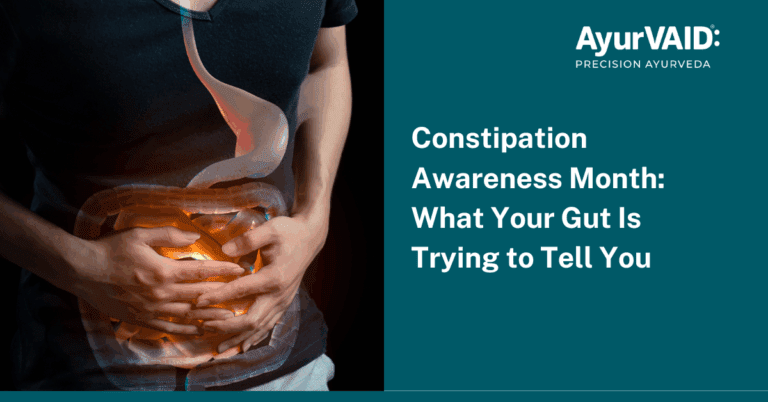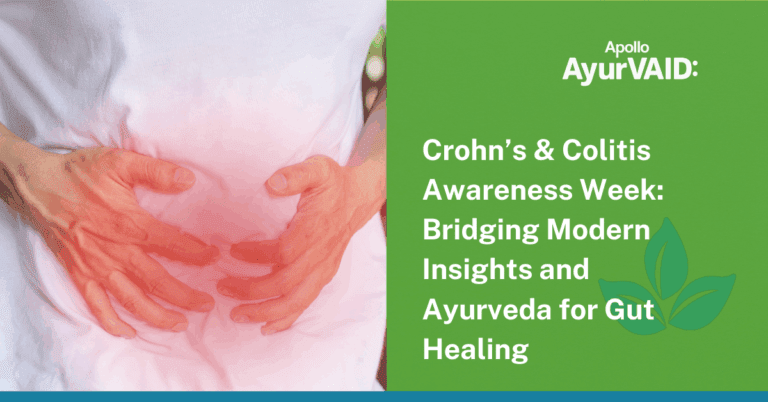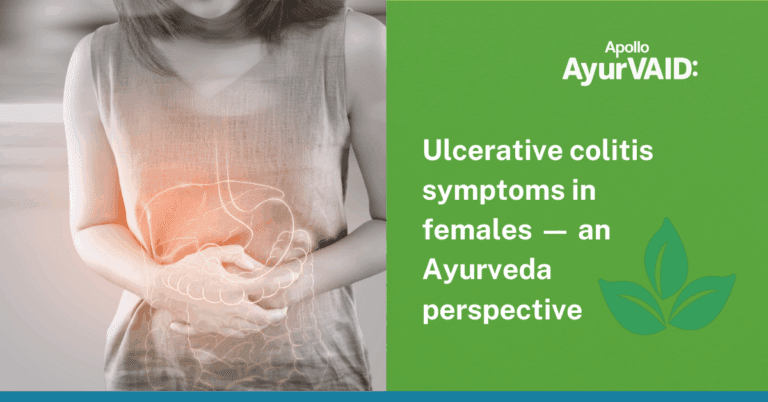Struggling with persistent digestive distress, unpredictable flare-ups, or exhaustion that just won’t quit can be overwhelming. For so many, these symptoms can be indicative of inflammatory bowel disease (IBD), a group of chronic gastrointestinal diseases that include Crohn’s disease and Ulcerative Colitis. Though they can seem similar on the surface — having similar symptoms of diarrhoea, abdominal pain, and weight loss — they are different in how they impact the body and how they’re treated.
Knowing the difference between ulcerative colitis and Crohn’s disease is the first step to identifying the proper care, alleviating symptoms, and taking back control of daily life. Alongside contemporary medical understanding, Ayurveda brings a distinctive, holistic approach, considering not only the disease but the individual.
In this blog, we’ll explore how these two conditions differ, what signs to watch for, and how Ayurveda approaches can help in managing them with compassion and clarity.

Difference between Ulcerative Colitis and Crohn’s disease
Feature | Ulcerative Colitis (UC) | Crohn’s Disease (CD) |
Affected Region | Limited to the colon and rectum | Can affect any part of GI tract (mouth to anus) |
Pattern of Inflammation | Continuous, starting from the rectum and extending proximally | Discontinuous (“skip lesions”) with healthy bowel between inflamed areas |
Depth of Inflammation | Mucosal (affects only the innermost lining) | Transmural (affects all layers of the bowel wall) |
Common Sites | Rectum and colon | The terminal ileum and colon are most commonly affected |
Histological Features | Severe crypt distortion, decreased crypt density | Discontinuous inflammation, focal cryptitis, and non-caseating granulomas are often present |
Complications | Risk of colorectal cancer, fulminant colitis, toxic megacolon | Strictures, bowel obstruction, fistulas, abscesses |
Surgical Implication | Colectomy can be curative | Surgery may be needed, but it is not curative; the disease may recur elsewhere |
Cancer Risk | Increased colorectal cancer risk over time | Lower cancer risk than UC, but still elevated vs. the general population |
Ulcerative Colitis Symptoms
Primary symptoms:
- Diarrhoea (frequent, may contain blood or mucus) – seen in ~95% of cases
- Rectal bleeding – present in ~91% of cases
- Abdominal pain or cramping
- Tenesmus (feeling of incomplete evacuation)
- Weight loss (due to reduced appetite and malabsorption)
- Fever (especially during flare-ups)
Severity:
- Symptoms can range from mild to severe
- Severe cases may require hospitalisation
Extraintestinal symptoms (in ~24% of patients):
- Joint pain
- Skin lesions (e.g., erythema nodosum, pyoderma gangrenosum)
- Eye inflammation (e.g., uveitis, episcleritis)
Crohn’s Disease Symptoms
- Abdominal pain, cramping, and chronic diarrhoea typically constitute Crohn’s disease manifestations.
- Weight loss is another frequently reported symptom, afflicting approximately 93% of symptomatic patients.
- Fatigue is a major and incapacitating symptom in 86% of cases.
- Sleep disturbances affect around 76% of people, with problems ranging from difficulty sleeping to an urge to sleep in daytime hours.
- Additional signs include fever, nausea, and vomiting, which tend to occur during flares.
- Perianal disease is common in many patients and may cause pain, anal fissures, or fistulas.
- Mouth sores may also develop in some patients.
- The disease usually follows a flare-remission course, with symptoms ranging from mild to severe.
Crohn’s disease, being an inflammatory condition, is correlated in Ayurveda with high Pitta in the intestines and colon. It can be related to conditions like Atisara/Pittaja Atisara (diarrhoea due to high pitta), Raktatisara (diarrhoea due to vitiated blood), and Pittaja Grahani (inflammation of the small bowel due to vitiated pitta). The concept of Ashayapakarsha, where vitiated vata pulls down pitta into the colon, is also associated with inflammatory bowel conditions, including Crohn’s.
How serious is Crohn’s disease
Permanent Cure for Ulcerative Colitis
Ulcerative Colitis Treatment
Ayurveda offers comprehensive Ulcerative Colitis treatment, including Panchakarma, herbal medicines, home remedies, and diet. Ulcerative Colitis treatment in Ayurveda focuses on balancing vitiated Pitta and Vata doshas, healing intestinal ulcers (vrana shodana and ropana), and promoting bowel regularity (grahi and stambhana properties). Treatments mentioned include Vasti (enema). Piccha Vasti, a special enema, is specifically mentioned for bleeding disorders and inflammatory bowel disease with bleeding. Diet recommendations include old rice, rice washed water, liquid lentils, buttermilk, goat milk, ghee, and astringent foods like banana flowers/unripe fruit, honey, jamun, bael fruit, pomegranate, and lotus stalk. Foods to avoid include those hard to digest, high in fibre, increasing bowel motility or Pitta, alcohol, coffee, tea, milk, dried fruits, spicy food, peas, legumes, and curds. Panchakarma therapies like Pittahara vasti and Piccha Basti are used, while others like body massage and sweating therapy are generally avoided.
Crohn’s Disease Treatment
Conclusion







